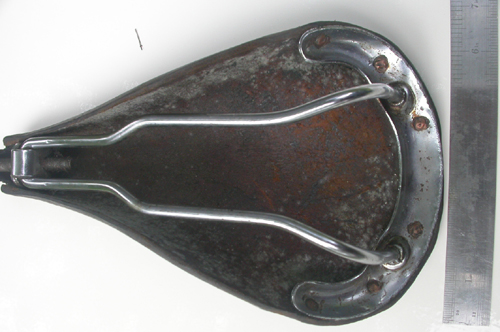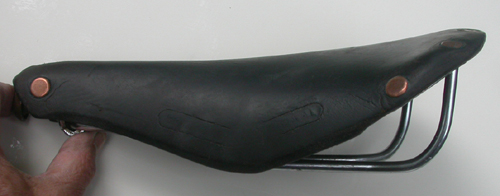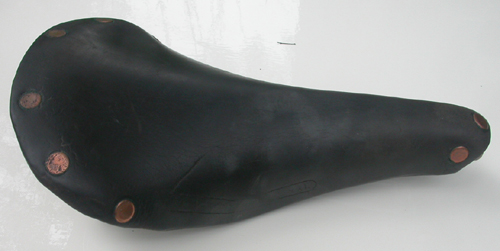Vol. 2, Issue 72 - November / December 2017
Posted: Thursday 16th November 2017
Since the last edition we have held the annual Ephgrave Ride here at Cambridge, I have lost count of the number of years we have done this now. We had to change the original date and wondered if this would affect the turnout, which it did to an extent as the event clashed with another not too many miles away. Come the day we had sixteen entries which was quite good given all that went on in the lead up. This event starts about half-mile from the Duxford Air Museum and we are lucky most years in that we can spend some time on the homeward leg watching part of the Battle of Britain air display.
We start this ride some nine miles from Cambridge as this gives us access to some of the Essex hills, making this ride somewhat different to some of the others held on flatter courses. Ever since the years of Terry Blake’s organisation of the ride it has been traditional to choose a hilly route and we have kept to this custom. One slight disadvantage is that my Ephgrave is a track/time trial model and uses fixed wheel – a few years ago I used to ride it on this event but although I may well be able to cope now I don’t want to find out that I cannot in the middle of a group ride and suffer the ignominy of pushing uphill. A few do ride this route on fixed each year and I envy them now although I do still ride fixed on less hilly rides. Among the riders was a National 800m track champion and unsurprisingly he romped up the inclines on his father’s Trevor Jarvis Flying Gate. Father was on an early Ephgrave.
Last Sunday we joined the Hampshire Lightweight Section for their annual end-of-season ride starting at The Roman Palace, Fishbourne just outside Chichester. As it was a flat ride I was able to ride my Gillott Fleur de Lis (Gillott spelling) while Patricia took her Pennine Richmond, a bike with a League tradition, being lively on the hills and very responsive. I built the Gillott with the very best components I could source for a 1956 machine. It has Harden ‘Bacon Slicers’ built in Dunlop Light Alloy HP rims with 15/17 double-butted spokes, Chater-Lea chainset and pedals with Christoph clips and straps, Brooks Swallow saddle and a very nice matching (almost) Holdsworth ‘Allez’ steel lugged stem with Maes alloy bars painted to match the black frame rather than scarlet as shown below.
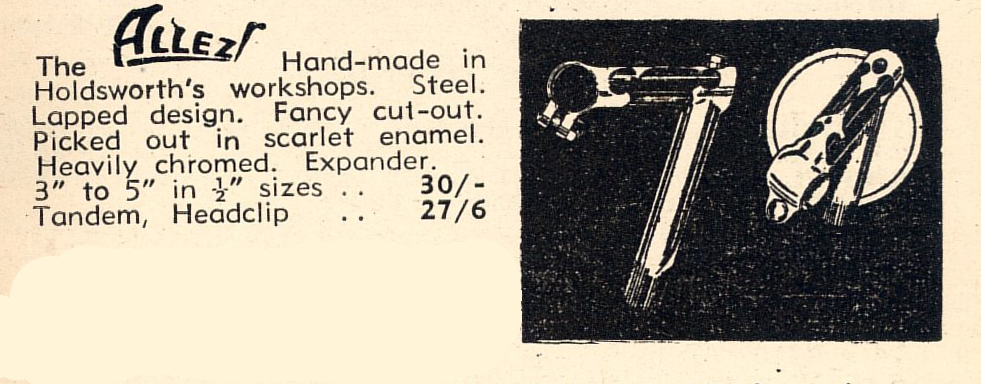
This just leaves the single brake which is GB of course.
Every year the Section gets a good turnout for both their Start and End-of-Season rides and they excelled themselves this year with an entry of fifty riders all on beautiful classic lightweights so we were able to meet up with many friends – as well as new enthusiasts. There were a few ups and downs along the way out but I felt quite happy on fixed and I felt I was in good company as there were several other riders on fixed.
Due to the large numbers involved the organiser divided the ride into three groups and sent the faster ones off first led by our old friend Bob Damper. Luckily we managed to ‘qualify’ for this group and it bowled along at a good pace without many stops. We were the first to the lunch stop. This year they had to make do with snacks supplied by the local Sea Scouts on the waterfront near Emsworth as their usual stop at a nearby marina club had burned down (a strangely common occurrence for VCC lunch venues!). Personally, I enjoyed adding to the scouting funds and they did very well catering for such a large group with very limited resources.
During lunch we were talking about a Garmin computer on someone’s bike and a younger member asked how we knew times and speeds back in the 50s. I explained that very few riders could afford the stop watch/Terry watch clip combination that I had on the Gillott. I also described the speedometers of the day and how no serious cyclist would be seen with one. They consisted of a large circular component attached to the wheel near the hub with serrated teeth which turned a toothed wheel at the bottom of a long inner and outer cable. The cable led to a large speed dial mounted on the handlebars.
Mileage indicators were usually the Lucas device that clicked away as you rode and very few racing cyclists would be seen with one either but they were beloved of tourists eager to clock miles covered during trips.
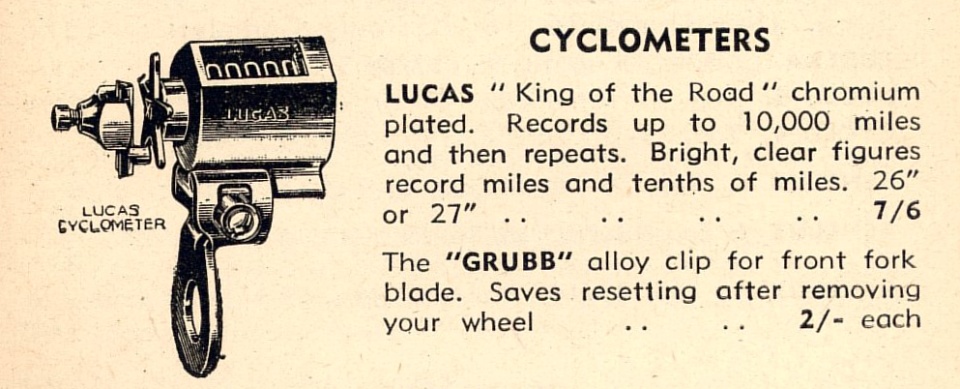
We will be riding through the coming winter, weather permitting , but there are not many organised lightweight rides to come now that the Fishbourne ride has passed. Our own section had rides all year round and while not lightweight-specific most Cambridge section people turn out on them. We are quite lucky to have reached November having only missed a couple of rides due to bad weather, and that in spite of being recognised as ‘Soft Southerners’ who cower indoors when rain is in the air.
Gears and racing in the 50’s By Keith Body
I rode a road race (or two) using the Campagnolo Paris/Roubaix professional single lever gear, in 1955. The main problem was (as with Osgear) you need to feed the chain straight in line to the rear cogs. I ground off the tops of the teeth to a slight curve. Also, it was difficult to define which gear you selected. I had 14 – 24 and 47 -50 with enough fork end length to get these extreme gears, with the Simplex front changer set very loose and slightly bent outwards. I could change up the front with the inside of my leg while releasing the wheel. The gear change wasn’t too slow. Glad you noticed that little cam to push the wheel forward as you lock up, otherwise the chain would be too tight.
I used Constrictor tubulars and road raced in the pouring rain on my Constrictor pre-war “first choice” laminated maple rims using normal brake blocks with no bad effects. The rims survived OK and the brakes worked in the wet. They were made by Honore Fossier in Paris, with 4 laminations. I used and sold all this old kit between 1954 and 1966.
Harden hubs, clear those golden memories – they weren’t that good. The cup and cone type were poor. I had one with integral bearings where the journals on the axle were too far apart, resulting in the hub floating sideways and wearing the shell. I also had (1952) the freewheel hub which dragged the chain. The main problem for British hub makers was changing from the 1.5 inch chain line, as they were making them for 4.5 inch rear ends. The gear side spokes were nearly vertical.
My Cyclo Benelux with handlebar controls would allow simultaneous front and rear gear changes off the saddle. Impossible with the Campagnolo, I think.
I was reading John Spooner’s piece about Brooks saddles. We used to do similar stuff. Also Brooks would reblock saddles free of charge. Reblock to them meant remoulding the saddle, sometimes making it longer, nothing to do with bending the frame. I had a very rare direct account with Brooks, and actually supplied Joe Whisker with some B17’s because he could not get them anywhere else. I bought the Colnago from him end of 1972, which Mrs B used till the end of her career. She had to adopt a road position for time trialling because of lacking her left collar bone.
I remember Ron Kitching bringing in the Cinellis, some the colour of your green one and the original colour of the best model with the internal sloping fork crown, which was a stone colour. Later of course that became orange. I was Ron’s major customer in the south in the early 60’s. I always got the 8 ounce Scheeren rims packed in the middle of a crate of 25 pairs of heavier rims. I always ordered quantity lots with extra discount.
I seem to remember Clive Parker finished the Pro World championships in the early 50’s about 20 minutes down. We all though this was an incredible performance as one of our pros actually finished.
Wedgelock cranks. I think they were made from redundant Dayton stock, originally hexagon, but rebroached to square. The problem was the force on the square split the cranks. When I asked the maker about this I had this wonderful reply: “Only a brutal and insensitive hand etc.” This was later frequently used to explain failures in anything, one of my favourite catch phrases.
BSA: Those hubs were cheap rubbish on cheap sports bikes. In 1950I had a BSA equipped with solid centre hubs with a medium size alloy flange which were equal to anything then. Sorry no pics, but the bike was a BSA Gold Column, genuine hand built, solid top eyes, butted 531, BSA own brazed on centre pull brakes, pedals with alloy side plates, B37, alloy 46T 5-pin chain ring, with Dunlop alloy HP’s and single fixed weighed 21 pounds.
Campagnolo: I must mention the Sport, important single roller parallelogram version, with the tension spring in the top arm. I got some from “Johnny” Bowles. Campagnolo had steel arms with bronze bushes, and we used to tap the rivets out and replace the top casting with the one with the internal tension spring. I think we had to take off the stop on the rear fork end, but it was a major improvement while supplies lasted. Most Campagnolo ends had a hole to anchor the spring.
Brooks saddles – blocking and butchering!
By John Spooner (who sadly died in 2017 and will be missed by many in the UK lightweight movement. He was a fount of knowledge and had a lovely disposition with a cheeky sense of humour.)
Having read Bernard Howard’s (‘Reminiscences’ – Memories of Cycling in the Fifties) mention of the ‘blocking’ of saddles on your site I thought I would add a little information to the subject.
I still have my 1960 Brooks B17F ‘French’ saddle supplied by Joe Whisker and I have asked lots of people from this era if they remember these saddles but no-one seems to recollect them. Maybe Joe only supplied a handful.
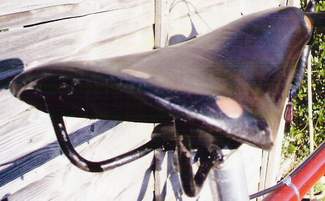
These saddles were specially made by Brooks for the Continental trade-team market which the teams then ‘butchered’ as required to suit their individual riders. The saddles had no holes in the top and no bag loops, they had standard size rivets and the leather was cut right back to the cantle-plate.
In 1961 Condor Cycles started to produce their own ‘Condor Brooks’ pre-shaped saddles at £2 18s. (see image below from Sporting Cyclist, February 1962) Also Pete Russel at his Velo Sport shop in Wandsworth Road (near Fred Dean’s) did a ‘Velo Sport’ pre-shaped saddle at £2 15s. I’m not sure if these were B17F or standard B17s before shaping.
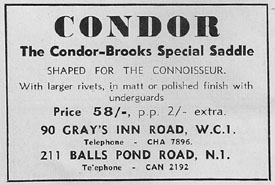
I have spent a whole morning ‘butchering’ my B17F saddle – here’s how to do it:
Hold the saddle rail close to the cantle plate one side at a time. Using a ‘Thor’ style copper/rawhide mallet beat each corner down a bit. Then, on a concave block of wood, lay the saddle upside down and beat the rear-middle of the cantle plate to give a curve. Do this slowly, a bit at a time, and keep checking until you are happy with the shape. Take care that the saddle does not become lop-sided! Then trim off the leather level with the cantle plate and cut back the nose leather making sure you don’t cut too close to the rivet. Now use a coarse file to smooth off the edges. If you can get them you can fit the larger copper rivets – only replace one at a time though. Changing the nose rivet is very tricky so maybe settle for just the rear ones.
To soften and waterproof a saddle I always used olive oil. Turn the saddle upside down and run oil onto the underside turning the saddle to encourage the oil to run around, especially near the rivets. Let the saddle soak overnight. This is why these saddles were undrilled. The leather can be hammered with the rawhide mallet to soften it. I have done this to my saddles since 1960 and no harm has come to the leather.
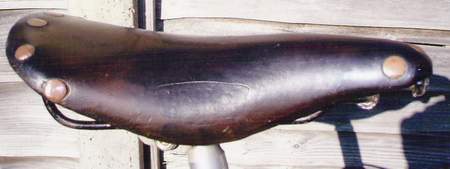
Many people will have their own ‘magic stuff’ to put on saddles, just the way they have recipes for embrocation. Olive oil and wintergreen was a favourite with riders but whether their girlfriends adored the pungent smell is another story!
‘Blocking’ is a term also used to restore distorted saddle tops. This can be done at home by soaking the saddle in warm water to get it really soft, then crumple up newspaper and stuff into the saddle to get the shape back. Be very careful and keep checking whilst the saddle is drying. Use a toestrap round the narrow part of the saddle to keep the shape intact while it is drying.
More details on the blocking of saddles in the 1940s and ‘50s By Alvin Smith, Paris Marque Enthusiast V-CC
Ken Janes remembered a similar service to that described by John Spooner and Bernard Howard that was provided by Harry Rensch of Rensch and later PARIS Cycles to his team riders and which he may have offered to any paying customer. Ken was employed by the firm between summer 1947 and 1948 and recalled that when not supervising others Harry could be found busy reshaping Brooks saddles. This was because the standard Brooks B17 had too much of a step from the peak to the cantle to allow a rider to slip backwards off it when beginning to ‘honk’ or dance on the pedals, particularly in comparison with the French Ideale saddle which had a smoother transition. Harry’s solution involved drilling out the rivets holding the leather to the cantle plate and saddle nose. Once the leather was removed, he would detach the original cantle plate with its wide sharply radiused ends and it in its place weld to the wire frame another cantle plate of his own manufacture. (see image below)
This one had a more gentle, sweeping radius –the aim being a more comfortable shape for the rider. The butt leather would then be stretched over the assembly (using specially made hook nosed pliers made by Ted Henderson) and then re-riveted. (image below)
Many riders favoured this design over that of the original Brooks pattern. The illustrations show just such a blocked saddle found on a very early PARIS Tour de France.
Users of the website will have realised that we don’t upload as much material as we used to. This is partly due to our decision to stop accepting new entries for Readers’ Bikes (we were getting a certain amount of aggravation hence the decision). Also we get less other suitable material submitted which was bound to happen some day. However we are happy to do what is needed to keep it ticking over and feel that is now regarded as a form of on-line encyclopaedia.
Slightly worrying is the lack of material for Lightweight News itself and I have taken to copying over pieces from the website I feel that people may have missed as it was published some time ago. One advantage of using ‘vintage’ material is that it doesn’t date in the way other stuff does.
The 6th North London Section GREAT CYCLE JUMBLE
Saturday 18th November 2017
At Tewin Memorial Hall, 11 Lower Green, Tewin, Hertfordshire. AL6 0JX
Time : Buyers : opens at 9.30am and closes 12.30pm
Stall and pitch Holders: available from 8.15am and everybody out by 1pm please.
Prices : Admission £1 for Buyers. (Before 9.30am £3).
Stalls and selling pitches : inside or outside £7. Only CLEAN jumble inside where a single table will be provided. Outside pitches in car park and provide your own table.
Parking : Free. Some parking available at adjacent bowls club. If parking in village be considerate please as we wish to come back next year.
Refreshments and indoor seating area available.
Tewin is a small village to the west of Hertford. It has pleasant lanes surrounding so make a cycling day of it. There are two pubs to retire to when the buying and selling becomes too much.
Near Welwyn Garden City. Just minutes from J6 A1(M)
Railway Stations : Hertford (3 miles) : Hertford North – Kings Cross/Stevenage line, Hertford East – Liverpool Street line. Welwyn North : (3.5 miles) – Kings Cross – Cambridge/Peterborough Line.
Posted: Thursday 16th November 2017
This article appears in the following categories.
Upcoming Events
Whether you are looking for a gentle social meet up, or a 100-mile ride browse the community’s upcoming events and plan your next weekend outing.

